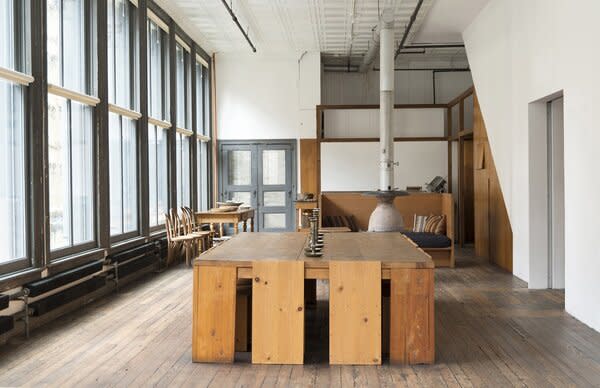Donald Judd’s Influence Is Way Bigger Than Kim Kardashian
The lawsuit over her dubious dining set illuminates a growing problem in furniture design: everyone wants the real thing, but nobody knows what that is.

Welcome to Field Guide, a column by Sami Reiss of Snake covering all-time design and where you can find it.
You don’t have to keep up with the Kardashians to know that Kim is in legal trouble over a dining table. In a widely reported lawsuit filed on March 27 in California, the Judd Foundation served the reality TV star for allegedly passing off knockoff Donald Judd pieces as the real deal in a since-deleted video tour of her Skims office. The items—a giant table and wood chairs—bear immediate resemblance to Judd’s La Mansana Table 22 and the 84 Chair.
Rainer Judd, the late artist’s daughter and president of the Judd Foundation, said in a statement that "Ms. Kardashian’s furniture is irrefutably fake," and that "the existence of inauthentic furniture undermines the integrity of his original work."
But for all her wealth and position, Kardashian isn’t alone in passing off fake Judd as real—nor is she alone in her appreciation of Judd, however inexactly expressed. You can find rip-offs, dupes, and recreations of Judd’s right-angled, tough works of furniture in just about every corner of the design world. Judd is mentioned as an influence by Prada’s Raf Simons in his recent interiors collection; an Ikea line from 2019 builds off of Judd’s minimalist themes. Lighting designer Peter B. Staples’s says he made a Judd-inspired sofa out of plywood, next to which he placed a beloved director’s chair. A near-Judd item in Kardashian’s workspace is just one high-viz example of how Judd’s design work has caught on—with celebrities boasting expensive signifiers of taste, and real designers influenced by Judd.
The wide chasm between Judd’s output, and what bears a likeness to it resurfaces an eternal question in art, one that’s especially of the moment in the design world since the pandemic. Is there a line between appreciation, inspired by, and ripping something off? And if so, where is it?
An entire industry of dupes and knock-offs is thriving and very much out in the open. As Dwell has reported on before, businesses including Wayfair and Aliexpress produce deferential pieces—or outright rips—downstream of real design artifacts, defining the market with mass-produced items explicitly modeled after famous designs, sold for pretty cheap. One website, called Dupe.com, helps consumers source them. (To be fair, dupes sometimes stand up in quality to newer, direct-to-consumer items.) Since patents for furniture expire after 15 years in the U.S., knockoffs abound; it’s why you see so many fake Eames Shell Chairs, with all sorts of legs. Legally, it can be tough for brands to control their design legacy.
That has been especially challenging for the Judd Foundation, since Judd’s work is easy to recreate. Clements Design, the Los Angeles studio that’s being sued for trademark and copyright infringement for creating Kim’s knock-offs, has demonstrated just how easy it is—and how consumers might easily become confused about whether a piece of nude wood is real Judd or just downstream of it. (Clements Design did not respond to requests for comment.)
The real stuff started in the 1970s in lower Manhattan, where Judd, an American artist associated with minimalism who died in 1994, began creating stark furniture for his loft. Early pieces were made from affordable materials, often untreated wood, and had lots of right angles. At its best, the work was incredibly arresting, and, just as much, broad: The Judd Foundation’s furniture website lists 92 pieces in stock. Per the Foundation, real Judd work was either made by Judd himself, or is sold by the Foundation, which supports itself from these sales, and which stamps and numbers each one. Because so many of the pieces are uncannily simple, they are easier, on a carpentry level, to knock off—or emulate—than many other designer pieces.
Which helps explain why the Judd Foundation operates at a tight grip. While Kardashian, as famous as anyone can get, is the most notable example of that, it’s not the Foundation’s first interaction with someone who it believes has overstepped. Mark Morones, an artist in Los Angeles who produces furniture, says he was served a cease and desist from the Foundation on March 24 of this year for a chair he put on his website that was a variation of Judd’s Chair 84. Morones’s chair, titled a "Judd Chair," followed the 84’s original profile, but featured cutout legs, and was made with zebrawood, Morones says, to give it "a fancy embellishment." On his website, Morones placed the chair he designed next to a photo of an original 84. "I think I’ve sold two of these in total," says Morones.
Morones says he wasn’t aware of any copyrights surrounding the chairs before his cease and desist. "These chairs are very common, for various reasons," he says, "with the dimensions of each listed (and even with dimensional drawings) available on their website, which led me to believe it was shared information for public consumption." Morones took the chairs off of his website after the cease and desist, and upgraded his Instagram post to make it evident the chair was no longer for sale.
See the full story on Dwell.com: Donald Judd’s Influence Is Way Bigger Than Kim Kardashian
Related stories:



